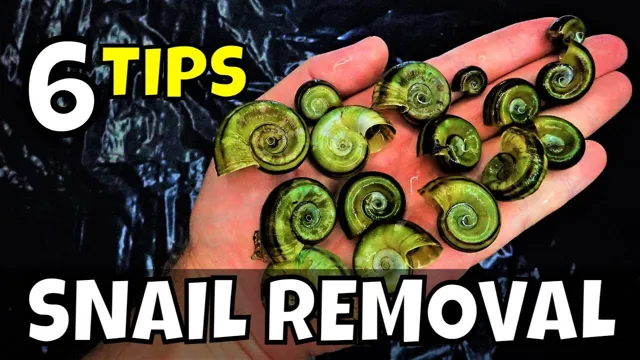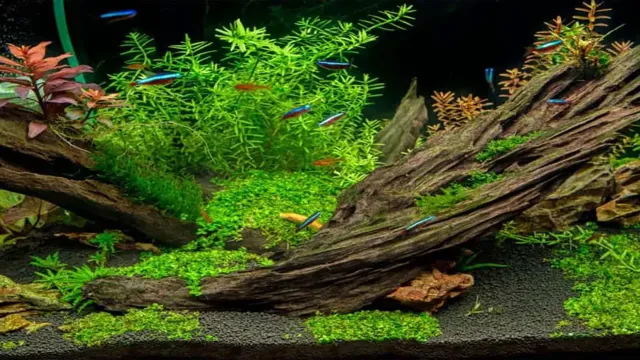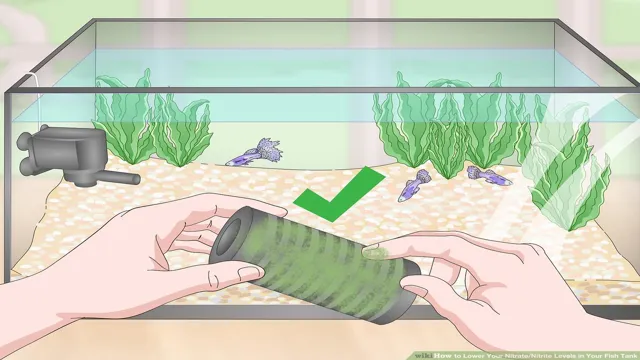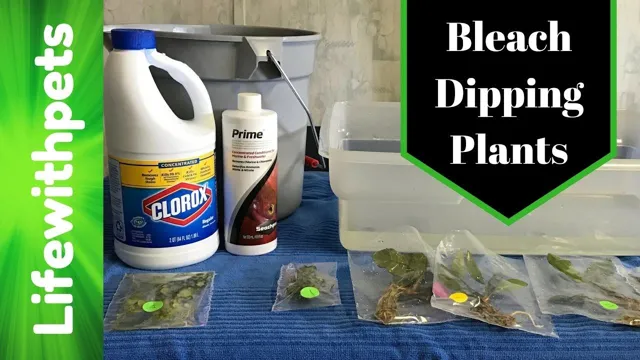If you’re an aquarium enthusiast, then you know the joys of having various aquatic animals living in your tank. However, sometimes unexpected visitors can make their way in – like snails! While they may seem harmless, snails can quickly become a nuisance in your aquarium by overpopulating and causing damage to aquatic plants. Don’t despair – there are several ways to get rid of them without harming your other fish or plants.
In this blog, we’ll explore some effective remedies and preventive measures to ensure your aquarium stays snail-free. So, let’s dive in and bid adieu to those pesky snails!
Identify the Type of Snails in Your Aquarium
If you’re wondering how to get rid of snails out of your aquarium, the first step is to identify the type of snails that you have. Different types of snails require different methods of removal, so it’s important to know what you’re dealing with. One common type of snail in aquariums is the pest snail.
These snails reproduce quickly and can become a nuisance if left unchecked. To get rid of them, you can manually remove them from the tank or introduce a predator that will eat them. Another type of snail is the apple snail, which is larger and less prolific than pest snails.
These snails are often kept as pets and can be controlled by limiting the amount of food in the tank and ensuring that the water quality is good. Whatever type of snails you have, it’s important to address the issue promptly so that they don’t damage your plants or overtake the tank.
Common Types of Snails in Aquariums
Identifying the type of snails in your aquarium can be a tricky task, as there are various types that are commonly found in fish tanks. Some of the most common species include the popular Nerite snail, which is known for its striking pattern and ability to clean up algae. Ramshorn snails are also often found in tanks, and can range in color from pale yellow to deep brown.
Mystery snails are another popular choice, and can grow quite large in size. Malaysian Trumpet snails are a common sight in many aquariums, as they can help to keep the substrate aerated and prevent the build up of toxins. By taking note of the size, shape, and color of the snails in your tank, you can get a better idea of what species you have, and what their particular needs might be.
Remember to do your research when it comes to maintaining a healthy and thriving aquarium!

How to Identify Snails in Your Aquarium
If you have an aquarium, chances are there are some snails living in there too. But identifying the type of snails in your aquarium can be tricky. One way to do this is to closely observe the shell shape and color.
For example, bladder snails have a pointed, elongated shell and are brown or black in color. Ramshorn snails have a distinctive spiral-shaped shell with a reddish-brown color. Nerite snails have a small, round, and smooth shell with bold patterns.
Another way to identify snails is by their behavior and habits. Mystery snails are often found at the water’s surface and can change the color of their shell based on their environment. Apple snails lay their eggs above the waterline and have long, cone-shaped shells.
By taking note of these characteristics, you can better understand the type of snails in your aquarium and provide them with the proper care they need.
Remove Snails by Hand
If you’re wondering how to get rid of snails out of your aquarium, one of the easiest ways is to simply remove them by hand. Although it may sound time-consuming, it can actually be a therapeutic and relaxing task that gets you up close and personal with your aquatic pets. Start by inspecting your tank carefully and identifying any spots with high snail density. (See Also: How to Make an Aquarium Herb Garden: A Step-by-Step Guide for Growing Fresh Herbs in Your Fish Tank)
Then, using a small net or tweezers, carefully scoop out the snails one by one and place them in a separate container. Alternatively, you can also use a plastic spoon or spatula to gently lift them out. Be sure to dispose of them properly and avoid introducing them back into your tank or other bodies of water as they may have harmful bacteria and parasites.
If you’re feeling extra adventurous, you can even try feeding them to some of your other pets such as turtles or fish. With patience and persistence, you can effectively control snail populations in your aquarium and maintain a healthy environment for all your aquatic creatures.
Using Your Hands to Remove Snails
If you’re dealing with snails in your garden or yard, one effective way to get rid of them is by removing them by hand. While it may not be the most pleasant task, it’s a natural and chemical-free method that can be highly effective. Start by checking moist and shady spots, as snails love these areas.
You can wear gloves if you prefer, but it’s not necessary. Simply pick up each snail and dispose of it in a container filled with soapy water. This will kill the snails without harming any other plants or insects in your garden.
You can also use a stick to gently lift snails off plants or surfaces if you don’t want to touch them directly. Removing snails by hand may take some time and effort, but it’s a great way to keep your garden healthy and free from harmful chemicals.
Best Practices for Removing Snails Manually
If you’re looking for a natural way to remove snails from your garden, then doing it by hand is a great option. Not only is it effective, but it’s also eco-friendly. The first step is to simply go out into your garden with a pair of gloves and a bucket.
Start by looking for areas where snails tend to congregate, such as under leaves or near damp soil. Next, carefully pick up the snails one by one and place them in the bucket. Try not to crush them, as this can release their eggs into your garden.
Once you’ve collected all the snails, dispose of them in a way that won’t harm other animals or your environment. It’s important to note that this method may take some time and effort, but it’s a great way to get rid of snails without using harmful chemicals.
Introduce Natural Predators
If you’re wondering how to get rid of snails out of your aquarium, introducing natural predators can be an effective solution. Snail-eating fish, like loaches and puffers, can be added to the tank to control the snail population. These fish will eat the snails without harming other aquatic life.
Another option is to introduce snail-eating invertebrates, such as assassin snails or crayfish, which can also help control the snail population. It’s important to research the specific predators you plan to introduce to ensure that they are compatible with the other inhabitants of your aquarium. Additionally, introducing too many predators can create an imbalance and harm the ecosystem, so it’s essential to monitor their population as well.
By incorporating these natural predators, you can effectively eradicate snails from your aquarium and create a healthier environment for your aquatic pets.
Fish That Eat Snails
If you’re struggling with snail populations taking over your aquarium, introducing natural predators can be an effective solution. There are many types of fish that eat snails, including loaches, pufferfish, and angelfish. These predators are adept at seeking out and consuming snails, which can help to control their populations. (See Also: How to Make Different Levels Inside an Aquarium: A Step-by-Step Guide)
Loaches, in particular, are known for their love of snails. They have long, slender bodies that allow them to fit into tight spaces where snails might be hiding. Pufferfish also make excellent snail predators, with their strong jaws and sharp beaks.
Angelfish, on the other hand, are more selective, preferring larger snails that they can swallow whole. While introducing natural predators can be an effective way to control snail populations, it’s important to ensure that your aquarium has enough space, food, and hiding spots for your fish to thrive. By carefully selecting the right predators for your aquarium and taking steps to support their health, you can keep your snail populations under control without resorting to harsh chemicals.
Other Natural Predators
Aside from birds of prey, other natural predators exist in the wild. One such predator is the coyote, which is known for its hunting prowess and adaptability. It is a common predator found in North and Central America.
Coyotes can be seen hunting alone or in packs, depending on the prey they are targeting. They mainly hunt small mammals like rabbits and rodents, but can also prey on larger animals like deer. Another natural predator is the fox, which belongs to the same family as coyotes.
Foxes can be found across the Northern Hemisphere and are known for their agility and speed. They mainly hunt small rodents and insects, but can also prey on birds and rabbits. These natural predators play an important role in controlling prey populations, which helps to maintain the balance of ecosystems.
Use Chemical Treatments as a Last Resort
If you’re wondering how to get rid of snails out of your aquarium, the last thing you want to turn to right away is chemical treatments. While they may be effective in killing the snails, they can also harm other aquarium inhabitants and upset the balance of your tank. Instead, it’s best to try natural methods first, such as removing the snails by hand or introducing snail-eating fish like loaches or puffers.
Additionally, ensuring proper aquarium maintenance and limiting overfeeding can help prevent snail populations from exploding in the first place. If all else fails and you must resort to a chemical treatment, be sure to closely follow the instructions and take special care to remove any dead snails from your aquarium to prevent toxin buildup. Remember, chemical treatments should only be used as a last resort and with caution.
Types of Chemical Treatments Available
Chemical treatments for water are available in various types and forms, including chlorine, chloramine, ozonation, and ultraviolet radiation. While these treatments can effectively eliminate harmful bacteria and microorganisms, it is crucial to keep in mind that they should be used as a last resort when considering water treatment options. The chemicals added to the water during the treatment process can alter the taste and odor of the water, as well as leave behind harmful byproducts that can pose additional health risks.
Additionally, chemical treatments can be costly and require specialized equipment and maintenance. It is best to explore other treatment options, such as filtration or reverse osmosis, before resorting to chemical treatments. By understanding the various types of treatments available, consumers can make informed decisions about how to ensure their water is safe for consumption without compromising quality or affecting the environment.
How to Apply Chemicals Safely in Your Aquarium
When it comes to maintaining a healthy aquarium, chemical treatments should always be used as a last resort. While they can be effective in treating certain issues, such as parasites or bacterial infections, they can also be harmful to the delicate balance of your aquarium’s ecosystem. Before applying any chemical treatment, it’s important to fully research the potential risks and side effects, and to consult with a professional if necessary.
It’s also important to follow dosage instructions carefully and never exceed the recommended amount. In general, regular maintenance and proper care should be enough to keep your aquarium healthy and thriving. By keeping a close eye on water quality, monitoring fish behavior, and taking corrective action when needed, you can minimize the need for chemical treatments and ensure a safe and comfortable environment for your aquatic pets.
Conclusion
In conclusion, the battle against snails in your aquarium requires a tactical approach. Firstly, ensure that your feeding regime is balanced and not overfeeding. Secondly, consider introducing snail-eating fish or aquatic creatures into your tank. (See Also: How to Create an All-in-One Aquarium – A Comprehensive Guide for Beginners)
Thirdly, you can opt for manual removal of visible snails or utilize a snail trap. Finally, keep up with regular tank maintenance to prevent a snail infestation from getting out of hand. Remember, with a little effort and technique, you can successfully rid your aquarium of pesky snails and establish a healthy ecosystem for your aquatic pets.
So, don’t be shellfish and give it a try!”
FAQs
What are some natural ways to get rid of snails in an aquarium?
Some natural ways to get rid of snails in an aquarium include using snail-eating fish, adding crushed snail shells to the aquarium, or placing a lettuce leaf in the aquarium at night to trap the snails.
How do I prevent snails from entering my aquarium?
You can prevent snails from entering your aquarium by thoroughly cleaning and sterilizing any new plants or decorations before adding them to the tank. Additionally, you can inspect any new fish for snails before adding them to the aquarium.
What types of snail-eating fish are best for controlling snail populations in an aquarium?
Some popular snail-eating fish include loaches, puffers, and certain types of cichlids. It’s important to research the specific needs of the fish you choose and ensure they are compatible with other fish in your aquarium.
Can I use chemical treatments to get rid of snails in my aquarium?
While there are chemical treatments available to control snail populations, these should be used with caution as they can harm other aquatic life in the aquarium. It’s important to carefully research any chemical treatments before using them.
How do I know if snails are causing problems in my aquarium?
Snails may cause problems in an aquarium by overpopulating and consuming too much of the tank’s food supply. Signs of a snail infestation can include excessive algae growth, deteriorating plant life, and an overall decrease in water quality.
Do snails serve any beneficial purpose in an aquarium?
Snails can serve a beneficial purpose in an aquarium by consuming algae and helping to aerate the substrate. However, if their population gets out of control, they can become a nuisance and cause problems for other aquatic life in the tank.
How often should I check for snails in my aquarium?
It’s a good idea to check for snails in your aquarium regularly, especially when adding new plants or decorations. A quick visual inspection a few times per week should be sufficient to catch any potential snail infestations before they get out of hand.







